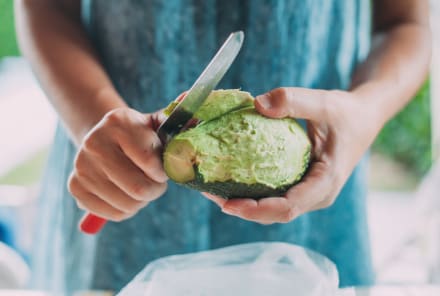Advertisement
Why A Preplanned Menu Can Inspire Healthy Eating, From Experts


No matter how much food I have in the fridge, sometimes I just don't feel motivated to cook. It's not because I don't have time or don't enjoy cooking but rather I lack the brainpower to think of something interesting, tasty, and nutritious to cook when my stomach is already rumbling. Can you relate?
If so, let me suggest building your menu ahead of time—I'm talking breakfast, lunch, dinner, and snacks, too. It's not meal prepping per se, but having options written down like a restaurant does. Here's a quick how-to and why this strategy works, from nutrition experts.
Why building a menu can help with healthy eating
At the end of a long day, you're probably dealing with two things: low energy and hunger—neither of which fosters creativity to plan a great meal. It's the same reason even build-your-own-meal restaurants often have pre-constructed menu items as well—not everyone wants to put in the effort. Sometimes, you just want to know what your options are.
This is why a menu can help. It eliminates the step where you're staring at the fridge knowing you have the ingredients to make something but feel unsure where to start.
Lead dietitian at Allara Health, Felice Ramallo, MSCN, R.D., L.D./C.D., agrees: "Some of the biggest barriers to healthy eating are feeling tired, hungry, and [having] low motivation at the end of an already busy day. By picking out meals or a menu to work from ahead of time, it can make choosing a healthier option easier."
Let's be clear: Making a menu is not the same as meal-prepping. Rather than knowing you're going to have a Caesar salad for lunch tomorrow, you'll know it's one of your options.
"One of the largest complaints about meal prepping in the traditional sense (everything cooked and portioned into its own box at the beginning of the week) is that it becomes mundane, loses freshness, and feels like the same song and dance night after night," Ramallo says.
So this hack is great for those who crave a bit of assistance on the planning front but don't love a full meal-prepping itinerary.
Plus, you may eat healthier because of it, as reaching for highly processed food is often more about convenience and hunger cues than true desire. "Thinking about what to eat is a normal process, but doing so when you're hungry can lead to less nutritious food choices," echoes family physician at One Medical Alexa Malchuk, M.D., MPH.
She adds, "For example, you may listen to your cravings (which when we're hungry, are often centered around sugar and sodium) and therefore eat less nutritious meals, or you may eat whatever is handy or visible, leading to overeating."
Building a menu won't eliminate the option of choosing less nutritious foods but rather will make the healthier option seem more desirable because half the work is done for you: picking what to eat.
How to do it
You can build your menu however you see fit. For me, I keep a running menu on a notes app on my phone. This makes it easy to glance at whenever needed and edit with ease. If a piece of paper on the fridge works better for you, then go with that.
I've experimented with creating the menu first, then making grocery list, and the other way around. In my experience, this process has been the easiest to follow:
Write down your first round of options
First, make an option for each meal. Here's an example from my list:
- Breakfast: A veggie egg scramble with a side of fruit
- Lunch: A tempeh sandwich with fresh produce and pesto
- Dinner: A burrito bowl with roasted tofu
- Snack: Yogurt with fresh fruit and granola
Start your grocery list
With just these options, you can begin to build your grocery list. Write down the essentials you'll need for just those three meals and one snack.
Rework the basics
Now it's time to get creative. Looking at those three meals and the items on your grocery list, what else could you make either without adding anything else or by adding one or two ingredients to the mix?
Could you turn that sandwich into a salad and add a tahini dressing instead of the pesto? Maybe you could put egg scramble on avocado toast? If you swap black beans for chickpeas and add tzatziki, maybe you could have a warm Mediterranean bowl for dinner? Using the yogurt from your snack and the lime and cilantro from the burrito bowl, can you make your own sauce? Bonus: Thinking this way can also help reduce food waste in your kitchen.
This can take time, which is why I recommend blocking out half an hour or so (when you aren't hungry, I might add) to flex your culinary creativity muscles.
Keep doing this until you have enough options to satisfy your needs for the week.
Head to the store
Once you take off for the grocery store, you'll go in with a plan, not just a list. Should an item at the store inspire you, add it to your list and write down another meal option you can make utilizing that additional item so you don't forget to use it.
Enjoy easier meal times
Now when you're getting home with little gas in the tank, you can look at the menu you crafted when your creativity was booming and know you have everything you need to make whatever sounds best in the moment.
Or when you need a midday snack you can easily gauge which option sounds best and fits the time crunch you're in.
Voilà! Your mealtime just got easier.
More tips
Here, a few more tips to make this process even smoother:
- Consult those you cook for: "For anyone who doesn't live alone, I would encourage they loop in their partner, families, etc. Getting buy-in from those you may be cooking for is totally necessary for mealtimes to go smoothly," she says.
- Prioritize balanced meals: When crafting your menu, make sure each meal has protein, produce of some kind, and a starch (preferably a whole grain, she says). When possible, do the same for snacks as well.
- Prep some items if needed: For the busy bees out there, consider prepping some elements that are seen across your meals—things like roasted vegetables, cooked grains, or proteins. You can mix and match these prepped items with different food accessories like sauces and spices to make it taste interesting, but this will help to cut your time in the kitchen down. You don't have to dedicate extra time to prepping but rather make a double batch when cooking your next meal.
- Use your resources: This designated planning time is a great opportunity to whip out those cookbooks you bought last year and look at any recipes you might have saved from social media. If you feel yourself hitting a roadblock, a fresh idea can really help accelerate the process.
My experience
I've used this menu hack for the last few months and have felt a significant change in my attitude toward cooking meals and crafting snacks. It's a small tweak that just takes a bit more intention at one point of my week (usually on the weekend), and it pays off when I'm saving time and frustration standing in front of the fridge at 7 p.m. on a Thursday night.
This method won't work for everyone, but it can be largely helpful for those who find themselves uninspired at mealtime or anyone who's unsure where to start on their grocery list. By proxy, you'll save yourself stress throughout the week.
As Malchuk says, "No one wants to make a decision when they're 'hangry.'"
The takeaway
If you don't like traditional meal prepping but want to make mealtime easier, I'd suggest giving this menu hack a try. This process eliminates the question of what you could make with the food in your fridge so you can focus on what sounds best and works for your schedule at the moment. Here, some recipes to inspire your next menu.
Watch Next
Enjoy some of our favorite clips from classes
Enjoy some of our favorite clips from classes
What Is Meditation?
Mindfulness/Spirituality | Light Watkins
Box Breathing
Mindfulness/Spirituality | Gwen Dittmar
What Breathwork Can Address
Mindfulness/Spirituality | Gwen Dittmar
The 8 Limbs of Yoga - What is Asana?
Yoga | Caley Alyssa
Two Standing Postures to Open Up Tight Hips
Yoga | Caley Alyssa
How Plants Can Optimize Athletic Performance
Nutrition | Rich Roll
What to Eat Before a Workout
Nutrition | Rich Roll
How Ayurveda Helps Us Navigate Modern Life
Nutrition | Sahara Rose
Messages About Love & Relationships
Love & Relationships | Esther Perel
Love Languages
Love & Relationships | Esther Perel
What Is Meditation?
Box Breathing
What Breathwork Can Address
The 8 Limbs of Yoga - What is Asana?
Two Standing Postures to Open Up Tight Hips
How Plants Can Optimize Athletic Performance
What to Eat Before a Workout
How Ayurveda Helps Us Navigate Modern Life
Messages About Love & Relationships
Love Languages
Advertisement

This Underconsumed Nutrient Helps Fight Gum Inflammation, Study Shows
Molly Knudsen, M.S., RDN

Research Shows Cognitive Longevity Depends On These 3 Critical Vitamins
Molly Knudsen, M.S., RDN

This Underconsumed Nutrient Helps Fight Gum Inflammation, Study Shows
Molly Knudsen, M.S., RDN

This Underconsumed Nutrient Helps Fight Gum Inflammation, Study Shows
Molly Knudsen, M.S., RDN

Research Shows Cognitive Longevity Depends On These 3 Critical Vitamins
Molly Knudsen, M.S., RDN

This Underconsumed Nutrient Helps Fight Gum Inflammation, Study Shows
Molly Knudsen, M.S., RDN











